The Audace-class destroyers were two guided missile destroyers built for the Italian Navy during the Cold War. An improvement of the Impavido class, these ships were designed for area air defence and ASW close protection with an heavy gun armament. They had with their Tartar SAM launcher the latest American radars and sonars, but were modernized in 1988-9 with the best and most modern weapons and electronics the by Italian industry of the time could offer in order to stay relevant as the next-gen Durant de La Penne class were completed and pending the first Orrizonte (FREMM) class Frigates being delivered in the 2000s.
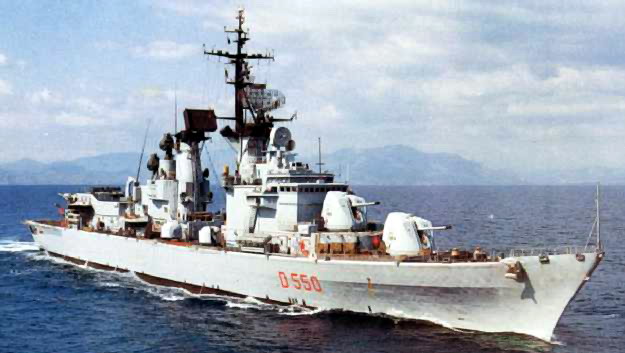
Development
The two ships were designed from 1965 as an improvement of the previous Impavido clas,s with an increase in size and displacement and strengthening the armament, in particular the anti-submarine suite by integrating two helicopters with a hangar.
In 1965 as the Impavido class were just being completed, the was the need to a qualitative improvement, n a lineage that started with the gun-armed Impetuoso class in service in 1957 and 1958. To face modern jets and nuclear-powered submarines, the Marina Militare needed a better platform. The Impavido class adressed the jet issue with the adoption of Tartar missiles, but remained deficient in anti-submarine warfare as she was too small to carry permanent helicopters.
They had a helideck though to at leas see the landing and take off of an AB.212 or previous models. The attempt to install two small Agusta A 106 aboard, built specifically for them, bore no fruits. There was also the need for more balanced anti-aircraft, anti-ship and anti-submarine capabilities, that caracterized modern destroyers. This made necessary and increase in size and displacement, which also anticipated on future improvements in capabilities.
The taller hull was give an accentuated bow sheer, divided into 16 watertight compartments. The sonar was integrated in a bulge of moderate size. The transome stern was made similar to the Andrea Doria class, supporting the flight deck, with the stern deck under for mooring operations. Superstructure were divided into two blocks with macks from the start and they had more spacious arrangement for better electronics.
Propulsion was not intended to be steam right away. Instead it was planned from the start a ropulsion system using Gas Turbines, either CODAG or CODOG but ultimately the fear of incurring long tests and developments had this prospect scrapped for a classic steam turbines arrangement. Both turbo-reduction groups would diverged also between different shipyards, Cantieri Navali Riuniti and Riva Trigoso, with a participation of Italcantieri, and Ansaldo Meccanico Nucleare as well as Finmeccanica.
In common they shared Foster Wheeler boilers but they differed for their powerplants, with CNR/Westinghouse steam turbines on Audace and Ansaldo/General Electric on Ardito. They had reducers of the double reduction which also differed in details and assembly. The steam steam supply systems were also completely differents. Even the boilers were not identical between the two ships, perhaps only the auxiliary diesels were truly common between the two and supplied by CNR. The two ships were authorized on 27 April 1968 for Audace and 19 July of the same year for Ardito. They were completed the same year with just a month between them.
Design of the class
Hull and general design
Their design was somewhat related to the previous Impavido class, but they were much larger, with ten years advanced in tech to incorporate more weapons systems, prove modular enough for future upgrade and additional sensors and weight. They hull was tailored for high sea conditions as primary goal rather than the Mediterranean only, notably for international NATO exerises, deployments and operations. For the first time in Italian shipbuilding they incorporated massive amount of aluminium alloys for the construction of superstructures. Ublike previous destroers for which helicopters were almost an afterthought, they incorporated an aft superstructure to house two AB-212 ASW helicopters. They were also designed to carry two types of torpedo tubes, with light ASW models and heavy anti-ship or ASW models. The two blocks had one macks, combinations of antenna masts and funnels and these were short trees. The two superstructure blocks were far apart and in general the ships were much larger than the Impavido class. Grossly, the forward part was dedicated to artillery and aft part to missiles and helicopters.
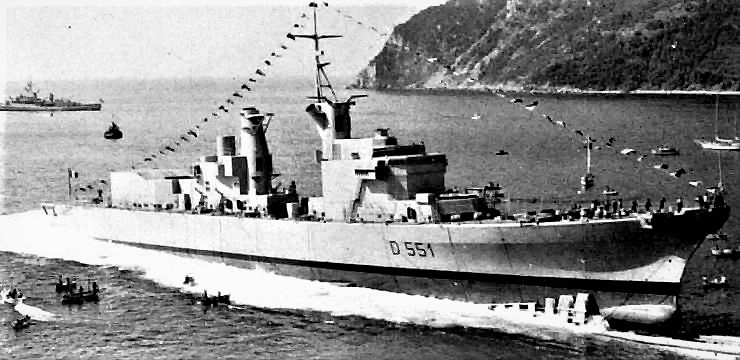
The Launch of Audace in 1972
Indeed the new destroyers were rated for a displacement of 3600t standard (versus 2,829 Tons standard) and 4400r fully loaded (versus 3,940 Tonnes FL). Same story for their size. They were 136.6 meters long overall or 448ft 3in (versus 130.9 meters or 429 ft 6 in), for a beam of 14.4 meters or 47fr 3in (versus 13.6 meters or 44 ft 7 in) and 4.6 meters or 15 ft (versus 4.5 m or 14 ft 9 in). The hull still shared the same flush deck appearance, but the freeboard was one deck higher. The prow had atlantic-type bulwarks and the hull ended with a clear transom cut stern, with a lower deck below the helideck in open air, housing the VDS. The way the two island superstructures were arranged with their macks looked like USN vessels like the Leahy/Belknap cruiser and Farragut class destroyers. The rear section was far more “busy” with the hangar, something that was sorely lacking on the Impavido class.
Powerplant
This aspect was perhaps the less innovative. For ships completed in Europe in the 1970s they still don’t swap in the CODOG bandwagon. This was not too different from France however wgicgh also stuck with the proven formula of steam turbines. These two steam-turbine were fed by four superheated Foster Wheeler boilers for a total of 73,000 hp on two shafts. They could thus reach 33 knots (61 km/h; 38 mph) with an endurance of 4,000 nautical miles (7,400 km; 4,600 mi) at 25 knots (46 km/h; 29 mph) if needed.
Armament
These destroyers were tasked to perform ASW defence, AA defence and classic anti-ship and shore bombardment missiles.
For the artillery part, which was generous, there was a departure from the 1960 Impavido class and its classic Mark 12 5-inches/38 twin turrets. By the way, the former destroyers only had a single turret forward. The new destroyers were more heavily armed with two main single turrets OTO Breda Compatto, 127mm guns in superfiring positions on the foredeck. They could fire 40 shells/minute.
In complement they were rounded by four 76mm OTO Melara Compatto placed mid-ship, two on either broadside. This made for a wall of fire of six guns either side, superior to what offered most destroyers at the time. Being missile ships, they combined this with their main air-defence system using the Tartar/SM-1, placed high up aft of the hangar.
The AA cover counted a three-layered approach with the missiles, main guns and secondaries, all fast-firing, whereas the 127 mm could also be used for naval bombardment or anti-ship operations.
The Tartar could also be reconfigured to fire on ships.
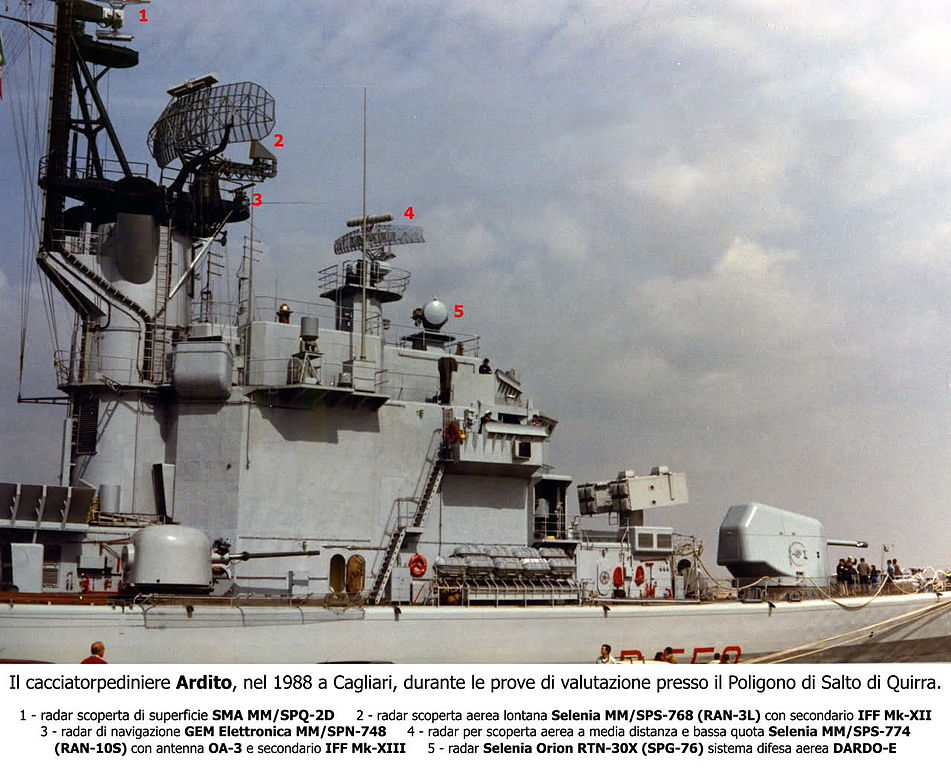
the ASW approach was well rounded too, but only centered on torpedoes: The Italian designed new A.184 heavy 533 mm wired torpedoes, a choice made instead of the ASROC missile. Although limited it was upgraded several time and improved during their career. This was completed by two class triple banks, ILAS-3 launchers with smaller light torpedoes of the A.244 or Mk46 models, also Italian or US built. The A.244 had better shallow-waters capabilities but were not on par with the Mk.44. Mk.46 torpedoes were better for deeper, faster targets though and the ships carried 12, combining both.
Tartar/RIM-24C SAM
Unlike the Impavido class that relied on the initial Tartar RIM-24A system designed in the late 1950s, the RIM-24 adopted, better known as the “standard” was a single launcher reloadable vertically. The 24C was likely the one obtained, as it was the latest made before the SM-1 Standard (RIM-66A). It was upgraded in 1987 to the latter and was the transition prototype.See also the Tartar Reliability Improvement Program (TRIP).
⚙ specifications Tartar RIM-24C |
|
| Weight | 594 kg (1,200 lb) |
| Dimensions | 4,572 m x 0,3429 m (186 in/135.5 in) |
| Propulsion | Solid Rocket Fuel, Dual thrust |
| Speed | 1,8 mach |
| Range | 16.5 nmi or 32,4 km |
| Guidance | FCS, SARH |
| Payload | 59 kgs HE (130 ib) |
Main OTO Breda 127 mm Compato
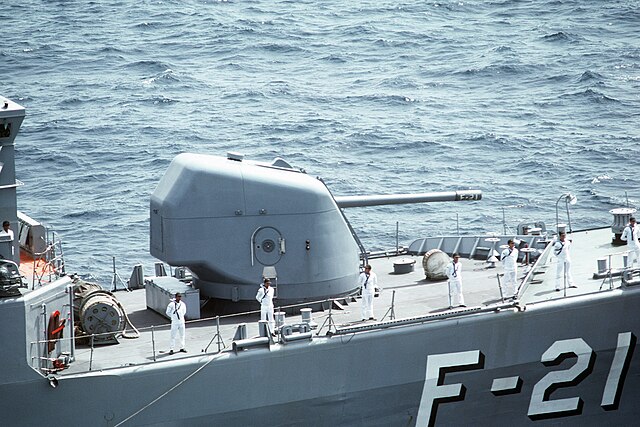
The Otobreda 127mm/54 Compact (127/54C) was designed as a dual purpose naval artillery piece using the same unbiquitous 127mm round of the USN 5 inch/54 gun. It had a large turret and an automatic loading system, loading sixty-six 127mm rounds stored in three ready-to-fire loader drums (22 each). The barrel is water-cooled and recently it had been replaced by the Otobreda 127/64. The model was largely exported. On the Audace class they are both located forward in superfiring positions.
⚙ 127mm/54 specs |
|
| Weight | U |
| Barrel length | 270 in (6.9 m) at 40°/s |
| Elevation/Traverse | −15°/+83°, 360° |
| Loading system | Automated drums, 22 rounds |
| Muzzle velocity | U |
| Range | ±30 km (100 km with guided VULCANO ammunition) |
| Guidance | Radar assisted |
| Crew | Remote controlled |
| Round | 127x835mmR 29-31 kg (64 to 68 lb) |
| Rate of Fire | 40 rounds/min |
OTO Melara 76 mm Compatto
The gun is characterized by a very high rate of fire, making it suitable bot for AA and anti-missile defense, using conventional ammunition, ranging from incendiary to armor-piercing and fragmentation with proximity fuse. It had been been adopted by 53 navies. Its fire control system was the RTN-10X Orion radar by Selenia and after 1987 updated to the RTN-30X (SPG-73).
⚙ specifications |
|
| Weight | 7.500 kg |
| Barrel length | 186 in (4.724 m) |
| Elevation/Traverse | -15°/+85°, 360° at 35°/s |
| Loading system | Fully Auto, barillet |
| Muzzle velocity | 3,000 – 3,024 fps (914 – 925 mps) |
| Range | accurate, 9,000 m, max 20,000 m |
| Guidance | RTN-10X Orion |
| Crew | Remote control |
| Round | 13.88 lbs. (6.296 kg), full 27.2 lbs. (12.34 kg) |
| Rate of Fire | 85 rds/min |
A 184 torpedoes (1974)
This was the standard wire guided heavyweight electric torpedo of the Marina Militare in the 1970s. It was fired by two B.516/A tube, stern-mounted in the transom. This torpedo had limited performance though in its first version, 10–12 km or 36 knots and 24 km/24 knots and was a conventional electrical torpedo with good countermeasures resistance, but modernized with several updates. It is better known in its latest variants as today’s “black shark”. This Whitehead-Motofides model which design started in 1971 replaced the 1965 Cangaro, a variant of the German G7e. Albeit wire guided it had also a digital active and passive terminal homing and used contra-rotating propellers. It was in service in 1974, two years after the completion of the Audace class.
⚙ specifications A 184 |
|
| Weight | 2,788 lbs. (1,265 kg) |
| Dimensions | 236 in. (6.000 m) |
| Propulsion | Silver-zinc battery |
| Range/speed setting | 10,900 yards (10,000 m)/36 knots, 27,300 yards (25,000 m)/24 knots |
| Warhead | 551 lbs. (250 kg) Explosive Charge |
| Max depth | c200m |
| Guidance | Wire, active/passive terminal |
A 244 torpedoes
Older than the A 184 and much smaller, the A-244 were designed from 1968 as an Italian replacement for the US Mark 44 Mod 2. It had a passive/active mode using a single frequency. Later the A-244/S was upgraded to triple frequency pulses and programmable seeker whereas the Mod 1 had pre-formed beams which shape could be changed to suit acoustic conditions.
The first was introduced in 1971 and was in service with the Audace class in alternative to the Mark 46. Upgrades were available in 1984 and 1987. They probably had in 1989 the new A-244/S mod 1.
⚙ specs. A 244 TORPEDO |
|
| Weight | 485 lbs. (220 kg) |
| Dimensions | 108.s in. (2.75 m) |
| Propulsion | Lead-acid Battery |
| Range/speed setting | 6,600 yards (6,000 m)/30 knots |
| Warhead | 75 lbs. (34 kg) |
Sensors
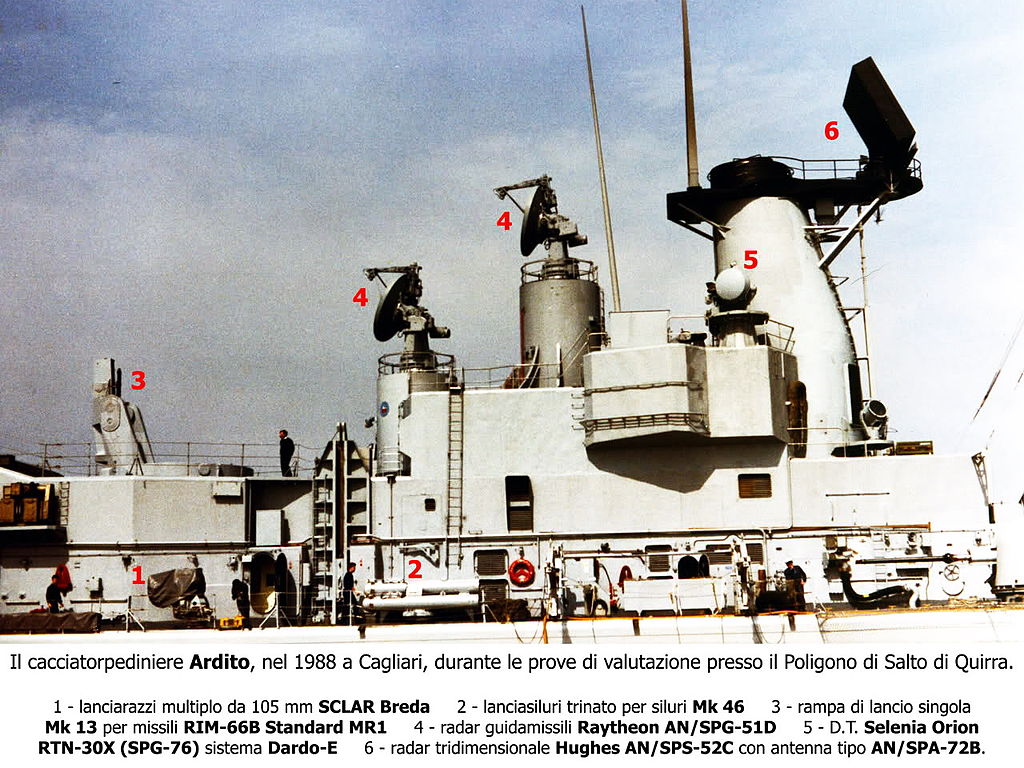
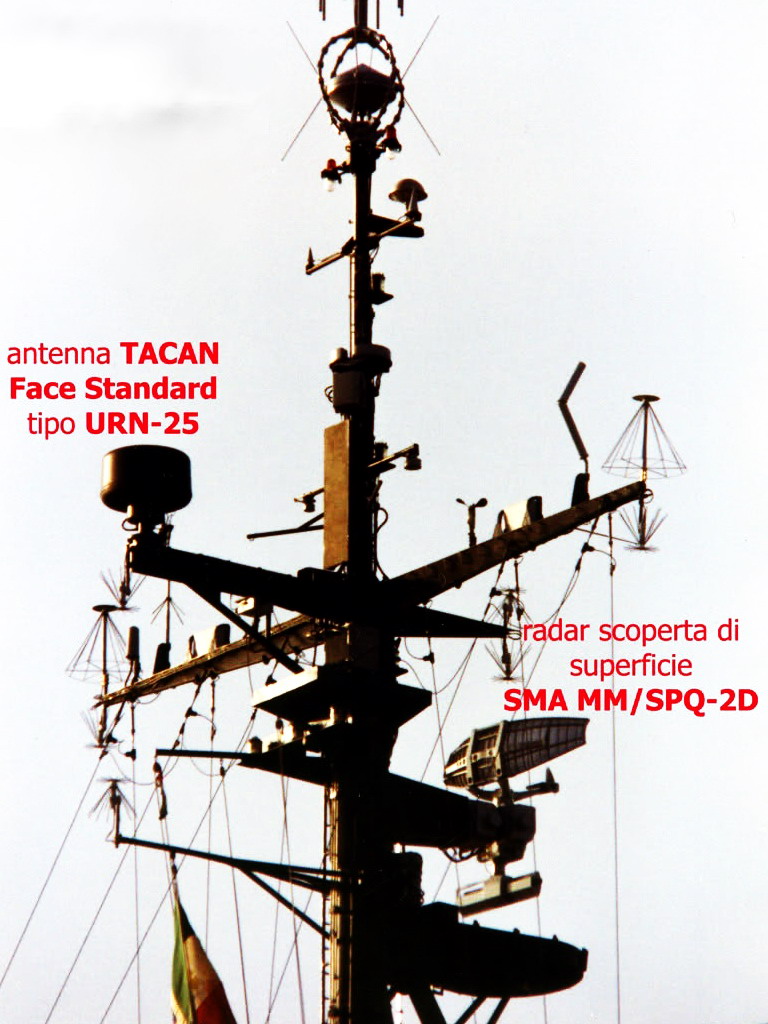
The Audace class combiend several systems derived from US models, but licence made in Italy:
-SPS-52 3-D radar: Aft mack, monitoring air space, altitude up to 300 kilometres (190 mi))
-RAN20S, 2-D radar: Fore mack, Italian complementary model. The combination was ideal for the Standard missile.
-SPQ-2 radar: For low-altitude air and surface search
-3M20 navigation radar: Fore mack. Both could be used for surface and low level aircraft detection.
-2x US-built SPG-51 illumination radars for the SM-1/Tartar, aft superstructure
-3x RTN-10x for gun control, over the turrion and midship , aft superstructure for the 76 mm guns.
-CWE610 hull sonar.
-2x SCLAR decoy rocket launcher and optional HE rockets.
-SADOC-1 combat ECM and communications system equivalent to NTDS.
The Audace class until 1989 had shortcomings as missile ships, notably the absence of any anti-ship missiles system but the small, short range AS-12, airbone. The Tartar could be used at the margin as anti-ship missile, but it lacked the right warhead to really impair its target. And neither was the SM-1 later.
Their truz strengt was on the short range, however, between their A.184, Mk46 torpedoes and two 127mm/four 76mm guns. The Tartar/SM-1MR missiles were esxcellent systems but could not deal with distant, fast high altitude bombers. The concept in1972 was however considered near-obsolete, although the USSR kept squadrons of Tu-142, Tu-16 and Tu-26 with the black sea fleet, all operating the latest and best anti-ship supersonic missiles. Their range opened the whole Mediterranean theater, provided they could enter many NATO held air spaces. There was no real CIWS system on board even after the 1988 updates and there were still blind spots at low altitudes, notably aft. If given enough warning, the ships had to be quick to manoeuver.
Air Group
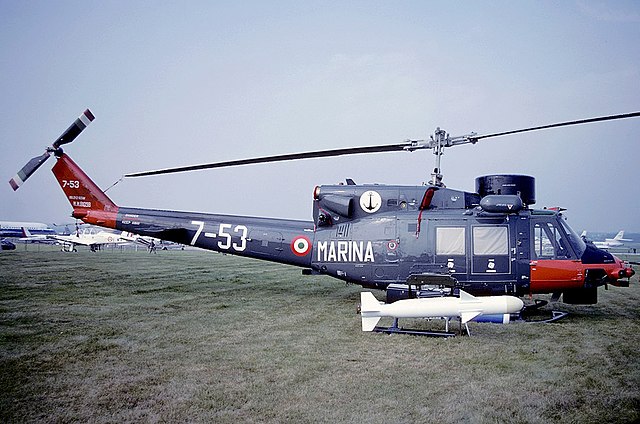
The major feature ofthese destroyer was their large helideck and roomy hangar aft, large enough to hosuse, repair and maintain two Agusta Bell AB-212 ASW medium helicopters. They were modified by Agusta to perform many naval roles, primarily ASW research and strike, search and rescue, anti-ship attack (with AS-12 missiles) and they werre almost comparable to the Westland Lynx. No larger model could be adopted as the SM-1/Tartar and its Mk 13 launcher and large carousel below deck filled the entire module. Both formed the long arm of these vessels, the rest, guns and torpedoes beong fairly short range.
AB 212 ASW Helicopters
⚙ Specs |
|
| Max Takeoff weight | 5,080 tons |
| Length | 14,02 meters |
| Rotor span | 14,5 meters |
| Height | 4,53 meters |
| Wing Area | |
| Engines | 2× Pratt & Whitney PT-6T-3 turboshaft engines (2000 hp) |
| Top Speed, sea level | 130 knots (240 km/h) |
| Cruise Speed | |
| Range | 360 NM (667 km) |
| Ceiling | 15000 feet (4570 m) |
| Armament | 1 x 7,62mm MG or 12,7mm MG / Mk-46 Torpedoes (ASW) |
| Crew | pilot, co-pilot, 2 operators |
Modernization
In 1988–1989 these ships had the “B” mount 127 mm gun turret removed and an octuple Albatros Aspide SAM launcher installed. The A.184 torpedo was also removed. There was a Teseo SSM system installed midship, between the 76mm guns and as the latter were replaced by 76/62 Super Rapido capable of 120 rpm. The Tartar SAM was replaced by the RIM-66, SM-1 SAM aft. This gave them much improved close-defence; and against ships that had a three layered bubble, with OTOMAT launcher for a long range anti-ship capability, especially coupled with an AB-212 for targeting over the horizon. The inner bubbles were covered by the SM-1, then the Aspide, and the 127 and 76 mm guns, with the removal of the second main turret compensated by the new “super rapido”. The intion was not just to gave them another ten years of service but bringing them to the same level of the Durant de La Penne class destroyers in construciton by 1991. Pas their completion, the two pairs ships could rotate for overseas deployment in any mission which needed serious combat capabilities.
The lack of a true VDS or variable depth sonar however was still an issue. They were also combat-vulnerable with the superstructures subjected to fire hazard and the amount of weapons and explosives in placed especially in the aft superstructure over 20 metres (66 ft) between the hangar and SAM missile storage. There was neither a true dedicated anti-missile weapon system either CIWS type super-high fire rate or light missile. The four 76 mm super-rapido had a limited arc of fire by their placement. By 1989 also their outdated machinery with the always present issues of aging boilers and lack of skilled personal for maintenance was a potential issue. The quickness and flexibility of CODOG and assimilated systems long made steam turbines a souvenir. It took time to activate the machinery, whereas a CODOG/COGOG could be run almost immediately at full power. In the end, whatever the upgrades planned, their useful operational life expired as the delayed Horizon program concluded. They were maintained only as an interim solution.
⚙ Audace class specifications |
|
| Displacement | 4,554 tons full load |
| Dimensions | 140.7 x 14.7 x 4.5m (461 ft 7 in x 48 ft 3 in x 14 ft 9 in) |
| Propulsion | 2-shaft geared steam turbines, 4 × Foster Wheeler boilers: 73,000 hp (54,000 kW) |
| Speed | 33 knots (61 km/h; 38 mph) |
| Range | 4,000 nmi (7,400 km; 4,600 mi) at 25 kn (46 km/h; 29 mph) on 3,000 nm at 20 knots |
| Armament | 2× 127 mm, 4 76/62 mm, 1 × Tartar SAM, 2×3 324 mm TTs, 2×3 533 mm |
| Armament 1987 | Same but Mk.29 Sea Sparrow/Aspide, Mk 13 SM-1MR, 8x Otomat SSM |
| Protection | 2x SCLAR decoy RL, SADOC CCS, 1987 SLQ-732 Nettuno ECM, SLQ-25 Nixie, SADOC-2 CCS |
| Sensors | SPS-12, SPS-52B, SPQ-2, 2x SPG-51B, 3x RTN-10X, SPN-748 radars, CWE-610 sonar |
| Sensors 1987 | SPS-768, SPS-774, SPS-52C, SPQ-2D, 2x SPG-51C, 3x SPG-76 radars |
| Air Group | 2x AB-212ASW helicopters |
| Crew | 380 |
Career of Audace class
 Audace D 551 (1971)
Audace D 551 (1971)
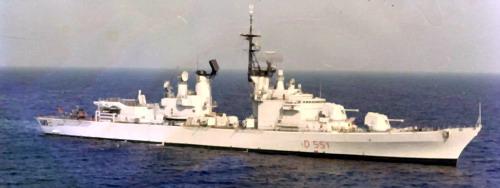
Audace D 551 was laid down at CNR, Riva Trigoso on 17 April 1968, launched on 2 October 1971 and completed in 16 December 1972. At the commissioning ceremony she received the Battle Flag from the municipality of Trieste in memory of 3 November 1918 when her namesake (audace(ii)) entered the city. The new Audace had an avene longer and richer active life, albeit not in wartime. She took part in numerous exercises and missions withing the NATO framework, not only in the Mediterranean. She saw service during the campaign in Somalia for the United Nations intervention from July 1982, and the participation in the intervention in Lebanon, from February to March 1984, as well as Operation Girasole in the Strait of Sicily during the Libyan crisis from May to July 1986 after an alleged Libyan missile attack against Lampedusa, where a LORAN station was located.
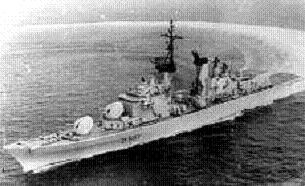 But she is best remembered for her long mission in the Persian Gulf from January to April 1991, as part Operation Desert Storm.
But she is best remembered for her long mission in the Persian Gulf from January to April 1991, as part Operation Desert Storm.
Her last significant mission was her part in the local and air surveillance during the the Kosovo war by the spring and summer of 1999. She patrolled also the coasts of Puglia, in front of Brindisi. Before she ended her career, her book scored 630,000 miles and 57,000 active service hours for the Regia Marina.
She was decommissioned in 2006 and by early May 2018 she was transferred to Aliaga to be broken up.
Her motto was “Gloria Audaciae Comes” previously assigned to the Regia Marina submarines Glauco (1905) of WWI and Glauco(ii) of 1935, whiuch saw action in WW2.
She paid homage to a destroyer laid down in 1912 and launched in 1913, lost in 1916. The second was from Yarrow shipyards in Glasgow ordered for the Japanese but repurchased by the Regia marina and entering service in 1916, Audace ii. She was the first to enter Trieste in November 1918 in what was called later Molo Audace. She was reclassified as a torpedo boat in 1929 and became an AA escort ship in 1942, captured by the Germans and used as TA 20 until sunk by the Royal Navy destroyers Avondale and Wheatland on 1 November 1944 near Pago.
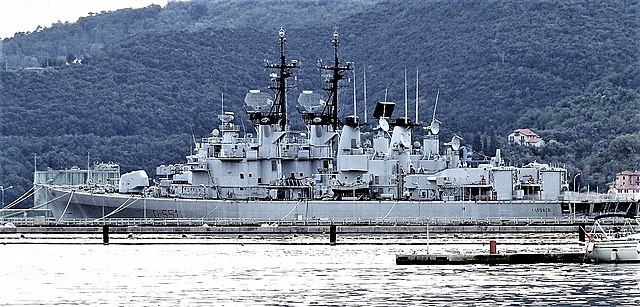
Audace in la Spezia, 2008
The new Audace was decommissioned on 28 September 2006, placed in reserve, mothballed, until scrapped in 2018.
 Ardito D 550 (1971)
Ardito D 550 (1971)
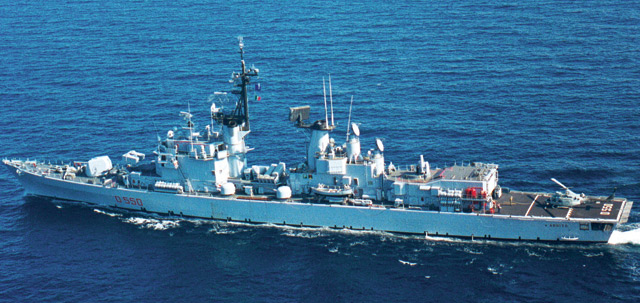
Ardito D 550 was laid down at Italcantieri, Castellamare di Stabia on 19 July 1968. She was launched on 27 November 1971 and commissioned on 5 December 1972
Ardito participated together with the frigate Lupo from 18 July 1979 to 4 February 1980 in a circumnavigation, making goodwill visits in 33 foreign ports under command of Admiral Enrico Rossi.
It had a radio link system coupled with the SIRIO Satellite communication system, successfully tested. The on-board antenna had automatic pointing correction according to the roll and pitch values of the ship. There was also a full-Duplex multi-mode transceiver system, installed before the cruise in service until the late 1980s major modification works.
From 2 July 1983 to 26 February 1984 she was part of the ITALCON mission in Lebanon, Beirut and stayed there for 3 missions over 198 days, in Lebanese territorial waters before departing for home on 26 February to Livorno. She was part of the parade of the “Folgore” paratroopers Brigade there attended by President Sandro Pertini.
Ardito by her name paid hommage to destroyer in service in 1912-1916, and another, from 1913 to 1944. Ardito was decommissioned on 28 September 2006, disarmed, stripped, then mothballed, and scrapped eventually in 2018.
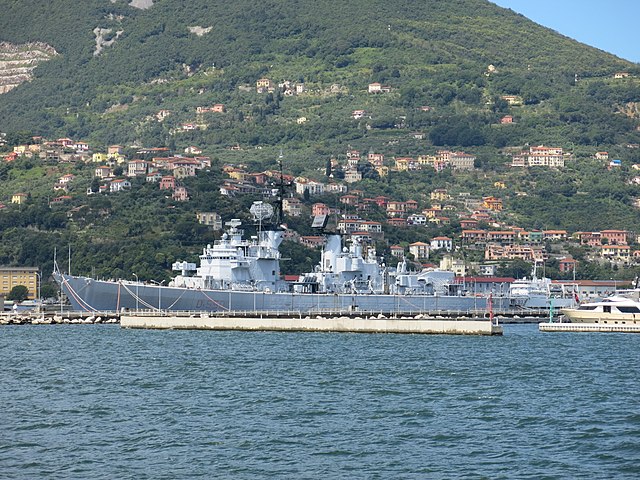
General Acception
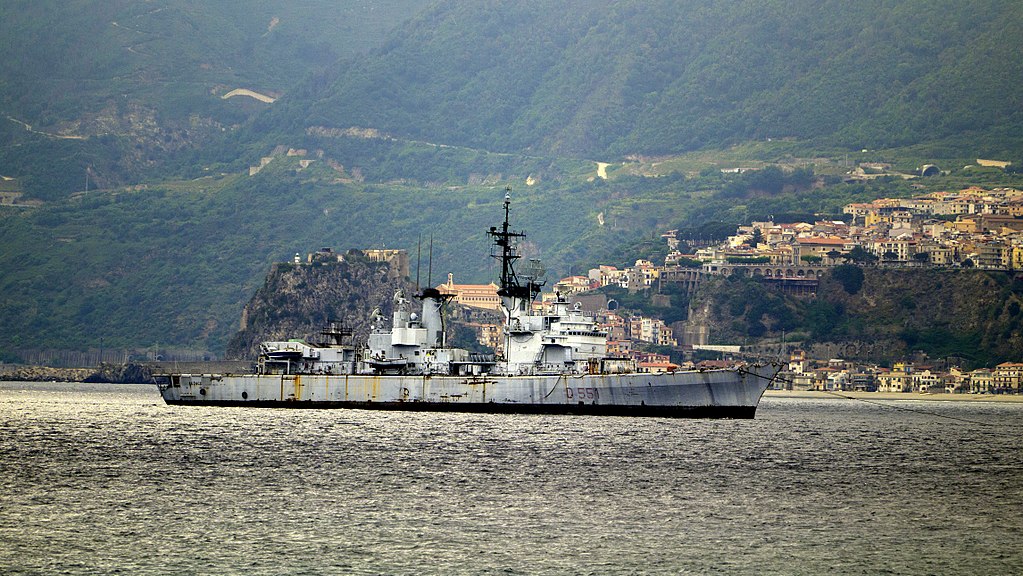
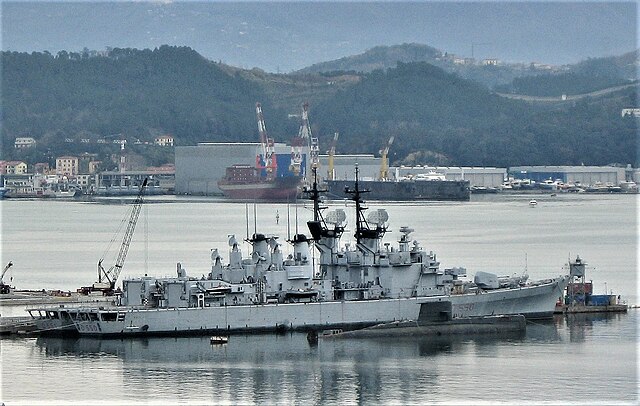
In the mothballs…
Upon entering service, the ships constituted a net improvement over the Impavido class, but yet suffered the comparison to other ships in many areas. Serious shortcomings comprised the lack of a proper central operation center, inadequacy of air search radar despite 2D/3D combiend radars, ack of a surface-to-surface missile system (The Otomat was not yet ready) with the Teseo system was still being tested on the hydrofoil Sparviero in 1974, adopted first by the Lupo class frigates from 1977. The third point was the propulsion system renouncing to Gas Turbines due to the fear of long tests and development that would dealay the entire class for many more years. As for detection, ECM and all-round armament, most shortcomings were overcome after 1989, with the exception of the propulsion. By 2008 there were practically no steam turbine ship left in service within NATO…
Read More/Src
Books
Conway’s All the World’s Fighting Ships 1947–1995
Po, Enrico, i caccia de La Penne, Rivista italiana Difesa (RID) n.6/93.
Armi da guerra enciclopedia, pag 863, De Agostini publisher, 1984. War Machines, Limited aerospace publishing, London
Links
https://it.wikipedia.org/wiki/Classe_Audace_(cacciatorpediniere_1971)
https://en.wikipedia.org/wiki/Audace-class_destroyer_(1971)
http://www.navweaps.com/Weapons/WNUS_3-62_mk75.php
https://www.globalsecurity.org/military/world/europe/audace.htm
https://www.marina.difesa.it/noi-siamo-la-marina/mezzi/mezzi-storici/Pagine/ABCD/audace68.aspx
https://napoli.repubblica.it/cronaca/2018/05/07/news/da_castellammare_alla_turchia_cosi_finisce_l_ardito_gloria_della_marina_italiana-195772281/
https://www.helis.com/database/sys/199-Audace-class
https://www.naveardito.it/
http://www.navweaps.com/Weapons/WTIT_List.php
https://www.marina.difesa.it/noi-siamo-la-marina/mezzi/mezzi-storici/Pagine/ABCD/ardito68.aspx
https://www.navypedia.org/ships/italy/it_dd_audace72.htm

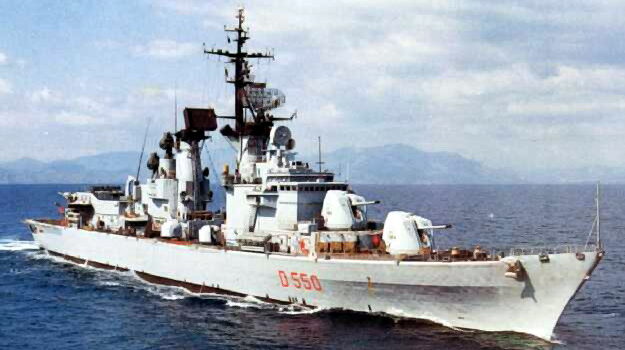
 Latest Facebook Entry -
Latest Facebook Entry -  X(Tweeter) Naval Encyclopedia's deck archive
X(Tweeter) Naval Encyclopedia's deck archive Instagram (@navalencyc)
Instagram (@navalencyc)





 French Navy
French Navy Royal Navy
Royal Navy Russian Navy
Russian Navy Armada Espanola
Armada Espanola Austrian Navy
Austrian Navy K.u.K. Kriegsmarine
K.u.K. Kriegsmarine Dansk Marine
Dansk Marine Nautiko Hellenon
Nautiko Hellenon Koninklije Marine 1870
Koninklije Marine 1870 Marinha do Brasil
Marinha do Brasil Osmanlı Donanması
Osmanlı Donanması Marina Do Peru
Marina Do Peru Marinha do Portugal
Marinha do Portugal Regia Marina 1870
Regia Marina 1870 Nihhon Kaigun 1870
Nihhon Kaigun 1870 Preußische Marine 1870
Preußische Marine 1870 Russkiy Flot 1870
Russkiy Flot 1870 Svenska marinen
Svenska marinen Søværnet
Søværnet Union Navy
Union Navy Confederate Navy
Confederate Navy Armada de Argentina
Armada de Argentina Imperial Chinese Navy
Imperial Chinese Navy Marinha do Portugal
Marinha do Portugal Mexico
Mexico Kaiserliche Marine
Kaiserliche Marine 1898 US Navy
1898 US Navy Sovietskiy Flot
Sovietskiy Flot Royal Canadian Navy
Royal Canadian Navy Royal Australian Navy
Royal Australian Navy RNZN Fleet
RNZN Fleet Chinese Navy 1937
Chinese Navy 1937 Kriegsmarine
Kriegsmarine Chilean Navy
Chilean Navy Danish Navy
Danish Navy Finnish Navy
Finnish Navy Hellenic Navy
Hellenic Navy Polish Navy
Polish Navy Romanian Navy
Romanian Navy Turkish Navy
Turkish Navy Royal Yugoslav Navy
Royal Yugoslav Navy Royal Thai Navy
Royal Thai Navy Minor Navies
Minor Navies Albania
Albania Austria
Austria Belgium
Belgium Columbia
Columbia Costa Rica
Costa Rica Cuba
Cuba Czechoslovakia
Czechoslovakia Dominican Republic
Dominican Republic Haiti
Haiti Hungary
Hungary Honduras
Honduras Estonia
Estonia Iceland
Iceland Eire
Eire Equador
Equador Iran
Iran Iraq
Iraq Latvia
Latvia Liberia
Liberia Lithuania
Lithuania Mandchukuo
Mandchukuo Morocco
Morocco Nicaragua
Nicaragua Persia
Persia San Salvador
San Salvador Sarawak
Sarawak Uruguay
Uruguay Venezuela
Venezuela Zanzibar
Zanzibar Warsaw Pact Navies
Warsaw Pact Navies Bulgaria
Bulgaria Hungary
Hungary

 Bundesmarine
Bundesmarine Dutch Navy
Dutch Navy Hellenic Navy
Hellenic Navy Marina Militare
Marina Militare Yugoslav Navy
Yugoslav Navy Chinese Navy
Chinese Navy Indian Navy
Indian Navy Indonesian Navy
Indonesian Navy JMSDF
JMSDF North Korean Navy
North Korean Navy Pakistani Navy
Pakistani Navy Philippines Navy
Philippines Navy ROKN
ROKN Rep. of Singapore Navy
Rep. of Singapore Navy Taiwanese Navy
Taiwanese Navy IDF Navy
IDF Navy Saudi Navy
Saudi Navy Royal New Zealand Navy
Royal New Zealand Navy Egyptian Navy
Egyptian Navy South African Navy
South African Navy






























 Ukrainian Navy
Ukrainian Navy dbodesign
dbodesign